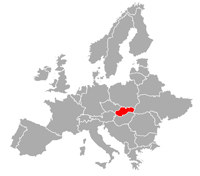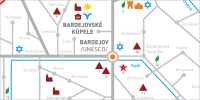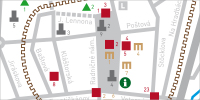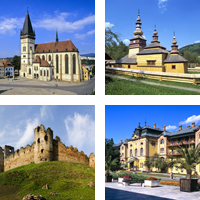   |
LEONARD STÖCKEL Humanist writer and theologian, Principal of Bardejov Grammar School Leonard Stöckel was born into a family of a Bardejov mayor and blacksmith. He studied in Košice, Wroclaw, and importantly at a university in Wittenberg under Martin Luther’s and Philipp Melanchthon’s supervision, both of whom influenced Leonard’s cultural and intellectual background, as well as his outlook on theology. After several years he had spent as a principal of the School in Eisleben (1534 – 1539) he returned to his hometown Bardejov to become the head ofthe local Latin School, which would eventually become outstanding under his leadership. The school earned its reputation as an institution attended by children from prominent aristocratic families. Stöckel would lead the institution until his death. Alongside theology classes, the school under Stöckel’s supervision offered subjects like physics, astronomy, music, poetry, Greek, etc. The study of drama was incorporated into the educational process. It was exactly this school which gave birth to a progressive idea that sculptures and paintings on altars are not merely cult objects but embody art and cultural values as well. Stöckel himself had written several textbooks. His school policy book “Legas scholae Bardphensis” (Laws of Bardejov School) is the oldest pedagogical document in Slovakia. In terms of theology, Stöckel was one of the major advocates of reformation in the Kingdom of Hungary. He had written several significant works in defense of Protestantism. His works “Notes to general principles of Christian theology by Philipp Melanchton” and the declaration of faith called “Confessio Pentapolitana” are exceptionally important. The latter served as a means for five then-Hungarian cities of Pentapolitana (including Bardejov) to adopt Protestantism. Leonard Stöckel significantly contributed to the cultural, spiritual and artistic enlightenment in the 16th century Bardejov. A statue of him can be found in the Alois Jirásek Park, in front of the present-day Leonard Stöckel Grammar School while his commemorative plate can be found on the house No. 11 at the Town Square where Stöckel used to live. Book printer, publisher and bookman Dávid Gutgesel founded the first printing house in Bardejov in 1577 after studying printing in Vienna. The printing house issued over 80 significant works during the twenty years of its existence, mostly concerning theology. The books were printed in Latin, Hungarian and German. In 1581, the already famous printing house issued the historically first book in Biblical Czech in Slovakia. It was a translation of Luther’s Small Catechism. Besides other works, Gutgesel issued writings of his contemporary Leonard Stöckel as well as Ioannes Bocatius’s humanistic works. The printing house also produced numerous works in defense of sacral monuments, which had been affected by the Reformation and especially its radical branch – Calvinism. The documents defending sacral monuments issued in Bardejov soon spread across the Kingdom of Hungary. That is how Bardejov greatly contributed to preservation of cultural heritage in many other towns. A commemorative plate, dedicated to the 400th anniversary of the founding of Gutgesel’s Print House is attached to the wall of the former humanist grammar school. Mayor and defender of Bardejov He was appointed the mayor of Bardejov in 1674, in the time of uprisings against Habsburgs. In 1678, he was captured by the armies of Count Imre Thököly and abducted to Transylvania. However, he managed to bail himself out by paying 800 florins and only a year later, in 1679, he regained his former position in Bardejov. He would die in the very same year in June, while defending the town. According to legend, it was his wife who was responsible for his untimely death as she had fallen in love with a handsome captain from Thököly’s army and gave him the keys from the town gate, which allowed the opponents to enter the town. However, when the mayor died whilst defending Bardejov, the adulteress came to regret what she had done. In order to repent her deed, she had a monument built for her husband, which stands by the fortification system up until the present day. The monument comprises a heart with a cross on a stand. |
JÁN ANDRAŠČÍK Priest, writer, cultural educator and national revivalist After studying theology in Pest he worked as a professor of theology in Košice. From 1832 to 1853, he served in Bardejov as a catholic priest. He raised cultural awareness, fought alcoholism or founded temperance clubs, while keeping in contact with leaders of the Slovak national movement like Francisci and Hamuliak. He was the first to publish a literary work in the local Šariš dialect. His anti-alcoholism play “Šenk paľenčeni” became famous and Michal Miloslav Hodža who would later translate it into the newly-codified Slovak language and thus helped it gain popularity on a national level. However, the contemporary authorities denounced the play as both Pan-Slavic and revolutionary and confiscated the first version of it. Although Andraščík’s work was driven by his love for ordinary people, he was the first to criticize and point out their vices and blunders. It was exactly these pursuits that would prevent him from attaining any significant position in the Church hierarchy. Andraščík died at a parish church in Bardejov completely destitute and was buried at the St. Michal Cemetery. A commemorative plate in his honor can be found attached to the wall of Roman Catholic parish building at the Town Square. A portrait of the priest is displayed in the Šariš Museum. Music composer, violinist and conductor His original name was Albert Paul von Kéler. He was born to a German noble family in Bardejov. He wrote over 200 compositions. “Erinnerung an Bartfeld”, which Johannes Brahms later would later include into his “5th Hungarian Dance” or the waltz called “Am schönen Rhein gedenk' ich Dein!” are his most famous works. His remarkable composing and conducting skills brought him considerable recognition during his life. In 1874, King Oscar II of Sweden and Norway awarded Kéler the gold medal “Litteris et Artibus” (displayed in Šariš Museum in Bardejov), Duke of Nassau awarded him Silver Cross for Art Achievements, King Wilhelm IV of Prussia awarded him a golden case with dedication, and Wilhelm I, German Emperor, also gave Kéler a gift. Even though Kéler used his Hungarian name Béla, he never learnt to speak Hungarian properly. Anyhow, he loved his hometown and often kept returning here after completing demanding music tours in order to relax and recover. He also donated his inheritance to the city of Bardejov. Catholic priest, politician and activist Eduard Kacvinský studied theology at the Collegium Pazmanianum in Vienna. After finishing his studies, he worked as a priest in a Bardejov catholic parish from 1857 to 1888. The period from 1863 to 1869, Kacvinský spent building the Calvary, which was originally the idea of his predecessor, Andraščík. After the fire in 1878, Kacvinský organized a huge reconstruction of the Church of St. Egidius. A gentle priest was also a member of both town and regional parliament, church commissary for grammar schools, cultural educator, abbot of the Holy Trinity Convent, and the Knight of The Order of the Iron Crown, 3rd Class. Kacvinský is buried in a tomb underneath the Church of St. Cross, which was built on the top of Calvary hill. A commendation plaque in honor of him can be found in the choir part of the church. |
VIKTOR MIŠKOVSKÝ Artist, educator, pioneer of historical monuments preservation He was born into a family of Polish gentry. He studied in Bardejov, Sátoraljaújhely, Rožňava, Levoča, Budapest and Vienna. He spent some time teaching in Bardejov and Kremnica, and worked as a professor of descriptive geometry and drawing in Košice. Miškovský had done a lot in the field of evidence, documentation, and description of historical monuments. He produced hundreds of drawings of historical artistic and engineering monuments. Working largely in the period before a widespread use of photography, his work was highly acclaimed. His work helped acquaint the public with the works of high aesthetic value in Austro-Hungarian Empire. He would receive many rewards for his work. In 1867, he was awarded the Gold Medal at the World Exposition in London. In 1878, he received the Silver Medal in Paris. In 1879, he was awarded the Gold Medal in Székesfehérvár. In 1896, he was awarded the Great Medal and Honor Scroll of exposition in Budapest. In 1897, he received the Knight’s Cross of Order of Franz Joseph. Present historians still reap benefits from Miškovský’s work. Many historical monuments have been restored owing to his drawings. Priest, politician, cultural educator and museum curator He became a priest in a Bardejov parish in 1913. Later on, he became a Pope’s prelate and vicar-general. Žebrácky was the mayor of Bardejov from 1924 to 1938, as well as a Deputy Chairman of the Slovak Museum Union. He also wrote educational agricultural articles, which helped raise the standard of living of the local people. He also organized a big fund-raising campaign amongst the Slovak emigrants in America in order to reconstruct the Church of St. Cross on the Calvary hill, which was damaged in the 1st World War. He had a good relationship with the famous Czech writer Alois Jirásek who visited Bardejov several times. He was a director at the Regional Museum (The Šariš Museum now), where he helped build collections and worked as a keeper for many years. The Hungarians tried to move the museum’s most precious showpieces to Budapest during the 1st World War. The retreating German army also attempted to seize some exhibits at the end of the 2nd World War. The fact that it never happened is one of Žebrácky’s great achievements. He was buried at the Calvary cemetery. RUDOLF LÖWY Politician, activist, heroic protector of the Jewish community Löwy worked in the Jewish Society for Culture and Education and was Council member. He was also a head of Tradesmen union and a chairman of the Jewish Community in Bardejov. When Jews started to be persecuted in 1938, he decided to fight the injustice by all means using his wit, contacts, and money. Löwy was one of the first people who received the information about the planned extermination of Jews in 1942. He was a member of “The Council of Six”, which sent a letter to the Slovak president Jozef Tiso, the ministers, MPs, and other powerful people, in an attempt to find some understanding and help. Without any success. Löwy became very upset when he found out that young Jewish girls were supposed to be the first deported. He suggested to gather all the gasoline and set the town on fire, thus fulfilling the biblical words of Samson from the Book of Judges: “Let me die with the Philistines!” However, Löwy managed to control his wrath and adopted a unique rescue strategy by using the Germans’ fear of contagious diseases. A number of girls received a double amount of typhus vaccination which sparked an imaginary epidemic. The results were surprising – from the hundreds of Jewish girls selected for deportation all the ones from Bardejov were released. Shortly after, Löwy managed to save the boys as well. Importance of this act is well illustrated by the statement pronounced by the regional Chief of Hlinka Guards: “Elimination of Löwy is as important as deporting a thousand Jews!” In 1942, the Minister of Home Affairs ordered to arrest Löwy. Beaten and covered with blood, Löwy was dragged to the railway station where he deported first to Žilina and then to Auschwitz. He died in the concentration camp after several weeks of torture. Translated by: |













